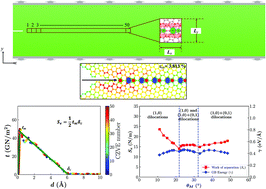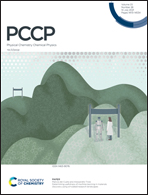Traction–separation laws of graphene grain boundaries
Abstract
Molecular dynamics simulations are used to extract the traction–separation laws (TSLs) of symmetric grain boundaries of graphene. Grain boundaries with realistic atomic structures are constructed using different types of dislocations. The TSLs of grain boundaries are extracted by using cohesive zone volume elements (CZVEs) ahead of the crack tip. The traction and separation of each cohesive zone volume element are calculated during the crack growth. The traction and separation values obtained for the cohesive elements predict that the TSLs of grain boundaries have a bilinear form. The areas under the traction–separation curves are used to calculate the separation energy of the grain boundaries. The results show that as the grain boundary misorientation angle increases the separation energy of the grain boundaries decreases. The impact of temperature on the traction separation laws is studied. The results show that, with an increase of the temperature from 0.1 K to 300 K, the separation energy first increases to reach its peak at around 25 K and then slightly decreases.



 Please wait while we load your content...
Please wait while we load your content...